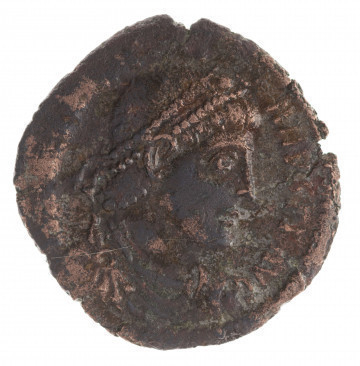
2/3 of a thaler (gulden)
1706
National Museum in Szczecin
Part of the collection: European and non-European coins
In the Middle Ages, the area of today’s Switzerland was treated as part of the German Reich. However, the Swiss gradually became independent, forming their own state based on a federation of autonomous cantons. In 1690, the so-called silver guilder, a coin worth two-thirds of an accounting thaler, appeared in the north of the Reich. It was quickly accepted in many states, including the Bishopric of Chur in the Swiss Canton of Grisons. The coin was introduced by Bishop Ulrich VI de Mont (1624–1692). On the obverse, the guilder has the eagle of the Reich and the name of Emperor Leopold I of Habsburg (1640–1705). The bishop of Chur was a duke-bishop of the Holy Roman Empire, and the diocese of Chur was subject to the archdiocese of Mainz. The situation is interesting because silver guilders and other related denominations were not recognised by Emperor Leopold I. The obverse of the coin depicts the half-figure of the patron saint of Grisons and the diocese of Chur, St Lucius (d. 2nd or 5th/6th century), in armour and with royal regalia. The image refers to one version of the origin of the saint, who was identified with a pagan king of Britain converted to Christianity and preaching the Gospel in Grisons. St Lucius, according to tradition, was also the first bishop of Chur. This is indicated a small inscription on the side of the saint’s head. Below the image of the patron there are two small shields of arms. One shows half of a Unicorn – the family coat of arms of Bishop Ulric, the other shows a goat clymant – the coat of arms of the Bishopric of Chur. The goat clymant is also found in the coat of arms of (Gross)– Engstingen, an estate of the Diocese of Chur in Swabia, of which the Bishop of Chur was lord. The production of bishop’s guilders was supervised by the mintmaster Balthasar Casutt. Silver guilders, unlike the thaler coins they replaced, participated in monetary circulation for a relatively short time. Since the middle of the 18th century, the 2/3 thaler denomination was gradually replaced by the light thaler minted according to the Prussian rate. The last coins worth 2/3 of a thaler were struck in Mecklenburg-Schwerin in 1845.
Mieszko Pawłowski
Other names
Silbergulden
Author / creator
Dimensions
cały obiekt: diameter: 37.9 mm
Object type
coin
Technique
minting
Material
silver
Creation time / dating
Creation / finding place
Owner
National Museum in Szczecin
Identification number
Location / status

1706
National Museum in Szczecin

1687
National Museum in Szczecin

367 — 375
National Museum in Lublin
DISCOVER this TOPIC
Museum of King Jan III's Palace at Wilanów
DISCOVER this PATH
Educational path